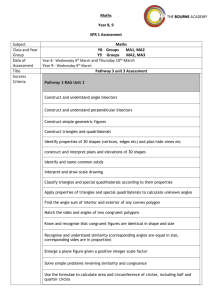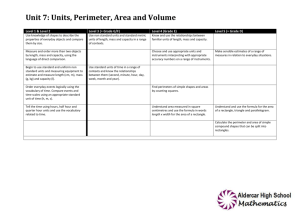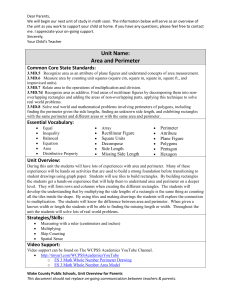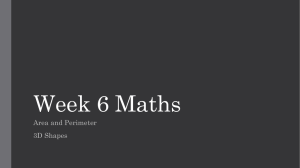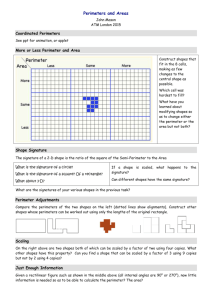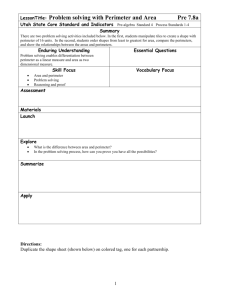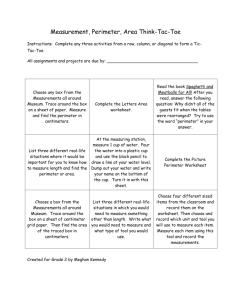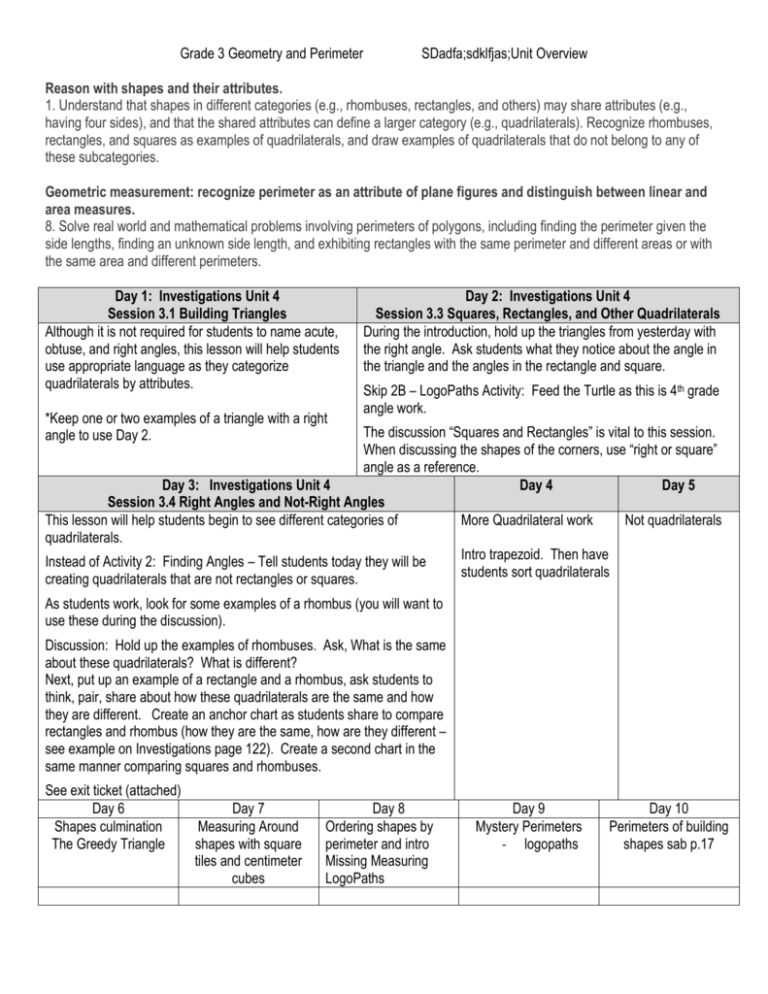
Grade 3 Geometry and Perimeter
SDadfa;sdklfjas;Unit Overview
Reason with shapes and their attributes.
1. Understand that shapes in different categories (e.g., rhombuses, rectangles, and others) may share attributes (e.g.,
having four sides), and that the shared attributes can define a larger category (e.g., quadrilaterals). Recognize rhombuses,
rectangles, and squares as examples of quadrilaterals, and draw examples of quadrilaterals that do not belong to any of
these subcategories.
Geometric measurement: recognize perimeter as an attribute of plane figures and distinguish between linear and
area measures.
8. Solve real world and mathematical problems involving perimeters of polygons, including finding the perimeter given the
side lengths, finding an unknown side length, and exhibiting rectangles with the same perimeter and different areas or with
the same area and different perimeters.
Day 1: Investigations Unit 4
Session 3.1 Building Triangles
Although it is not required for students to name acute,
obtuse, and right angles, this lesson will help students
use appropriate language as they categorize
quadrilaterals by attributes.
*Keep one or two examples of a triangle with a right
angle to use Day 2.
Day 2: Investigations Unit 4
Session 3.3 Squares, Rectangles, and Other Quadrilaterals
During the introduction, hold up the triangles from yesterday with
the right angle. Ask students what they notice about the angle in
the triangle and the angles in the rectangle and square.
Skip 2B – LogoPaths Activity: Feed the Turtle as this is 4th grade
angle work.
The discussion “Squares and Rectangles” is vital to this session.
When discussing the shapes of the corners, use “right or square”
angle as a reference.
Day 3: Investigations Unit 4
Day 4
Day 5
Session 3.4 Right Angles and Not-Right Angles
This lesson will help students begin to see different categories of
More Quadrilateral work
Not quadrilaterals
quadrilaterals.
Intro trapezoid. Then have
Instead of Activity 2: Finding Angles – Tell students today they will be
students sort quadrilaterals
creating quadrilaterals that are not rectangles or squares.
As students work, look for some examples of a rhombus (you will want to
use these during the discussion).
Discussion: Hold up the examples of rhombuses. Ask, What is the same
about these quadrilaterals? What is different?
Next, put up an example of a rectangle and a rhombus, ask students to
think, pair, share about how these quadrilaterals are the same and how
they are different. Create an anchor chart as students share to compare
rectangles and rhombus (how they are the same, how are they different –
see example on Investigations page 122). Create a second chart in the
same manner comparing squares and rhombuses.
See exit ticket (attached)
Day 6
Day 7
Shapes culmination
Measuring Around
The Greedy Triangle
shapes with square
tiles and centimeter
cubes
Day 8
Ordering shapes by
perimeter and intro
Missing Measuring
LogoPaths
Day 9
Mystery Perimeters
- logopaths
Day 10
Perimeters of building
shapes sab p.17
Name: ________________________
Day 3 Exit Ticket
Like Me, Like Me Not
Both of these shapes have 4 sides and 4 corners.
1. What is another attribute that they have in common?
2. Describe an attribute that is different between the two shapes above.
Name: ________________________
Day 3 Exit Ticket
Like Me, Like Me Not
Both of these shapes have 4 sides and 4 corners.
1. What is another attribute that they have in common?
2. Describe an attribute that is different between the two shapes above.
Day 4: Sorting Quadrilaterals
Reason with shapes and their attributes.
Emphasized Standards for Mathematical Practice:
3.G.1 Understand that shapes in different categories (e.g.,
rhombuses, rectangles, and others) may share attributes
3. Construct viable arguments and critique the reasoning
(e.g., having four sides), and that the shared attributes can
of others
define a larger category (e.g., quadrilaterals). Recognize
rhombuses, rectangles, and squares as examples of
5. Use appropriate tools strategically.
quadrilaterals, and draw examples of quadrilaterals that do
not belong to any of these subcategories.
6. Attend to precision.
Materials:
- Defining Quadrilaterals – overhead or record on poster
- Venn Diagram (sorting circles) for each pair of studentsmake out of large construction paper or string
- quadrilateral set (attached)
- What’s the Rule? Exit ticket
Words that you should hear students using in
mathematical conversations:
corner (angle)
quadrilateral
opposite sides
equal (congruent)
opposite sides won’t meet (parallel)
Ten Minute Math:
Practicing Place Value: Write 538 on the board and have students practice saying it to a partner. Make sure all students
can read, write, and say this number correctly. Ask students to find and sketch 5-6 different ways to make 538 using only
strips of 10 and single stickers.
Collect a few examples and ask students how they found their answers. Ask all students, “Did anyone notice a pattern?”
Before:
Defining Quadrilaterals. Have students look closely at the rhombuses and copy them in their math notebook. Then have
students record observations about rhombuses. Repeat with squares. Next, ask students “what would need to be done to
this rhombus to make it a square?” Why is there a square in the group of rhombuses?” After students have had some
time to think and write independently, have them get into groups of 4 and create a statement: For a rhombus to become a
square…
During:
Yesterday, we spent some time sorting quadrilaterals using different attributes (re-visit anchor chart). Today, we are going
to use Venn Diagrams to sort quadrilaterals. In a Venn Diagram all of the shapes in a circle follow the same rule.
Shapes in the part that overlap follow the rules in both circles. Today you are going to continue sorting quadrilaterals
using more than one attribute. You will choose two attributes from our anchor chart. Place shapes in the circle that
matches the attributes you selected. Remember to place shapes that have both attributes in the part of the circle that
overlap so that it is in both circles. If you have time, try to repeat with two new attributes.
Partner groups sort quadrilaterals using Venn Diagrams and attributes identified yesterday.
After:
One group had the attributes “all opposite sides will not meet” and “at least 1 square corner” Ask students, where should
they put the parallelogram (k), the right trapezoid (m), and the square (a)? Ask students to explain how they decided to
put it where they did in the Venn Diagram.
Evaluation:
What’s the Rule
Day 4: Before
Defining Quadrilaterals
Directions:
Look closely at the shapes in each group. What do all of the shapes in the group have in common? What do you notice
about the length of the sides? What do you notice about the corners? Will the opposite sides ever meet each other?
These are all rhombuses.
Observations about rhombuses
These are all squares.
Observations about squares.
When does a rhombus become a square?
MATHEMATICS • GRADE 3• UNIT 5: Geometry Georgia Department of Education
Dr. John D. Barge, State School Superintendent May 2012 • All Rights Reserved
Day 4: Exit Ticket – What’s the Rule?
Name:_______________
Draw each shape where it belongs in the Venn Diagram.
A
B
C
D
E
All Opposite Sides Equal
All opposite sides equal in length
No Square Corners
No square angles (corners)
Day 5: Properties of Quadrilaterals
Reason with shapes and their attributes.
Emphasized Standards for Mathematical Practice:
3.G.A.1 Understand that shapes in different categories (e.g.,
3. Construct viable arguments and critique the reasoning
rhombuses, rectangles, and others) may share attributes
of others
(e.g., having four sides), and that the shared attributes can
5. Use appropriate tools strategically.
define a larger category (e.g., quadrilaterals). Recognize
6. Attend to precision.
rhombuses, rectangles, and squares as examples of
7. Look for and make use of structure.
quadrilaterals, and draw examples of quadrilaterals that do
not belong to any of these subcategories.
Materials:
- Defining Quadrilaterals poster or overhead
- Triangle, dot or graph paper (students should choose
which to use) to create polygons
- Quadrilateral Riddles
- Square Disguise Exit Ticket
Words that you should hear students using in
mathematical conversations:
corner (angle)
quadrilateral
sides
opposite sides
equal (congruent)
opposite sides won’t meet (parallel)
Ten Minute Math:
Practicing Place Value: Say “one hundred twenty-three” and ask students to write the number. Make sure all students
can read, write, and say this number correctly. Ask students to solve these problems mentally
- what is 123+20? 123+40? 123+60? 123+200? 123+400? 123+600?
- Write each answer on the board. Ask students to compare each sum or difference with 637
- Which places have the same digits? Which do not? Why?
If time remains, pose additional similar problems using 261 and 198.
Before:
Defining Quadrilaterals. Have students look closely at the rectangles and copy them in their math notebook. Then have
students record observations about rectangles. Repeat with trapezoids. Next, ask students “what would need to be done
to a trapezoid to make it a rectangle?” After students have had some time to think and write independently, have them get
into groups of 4 and create a statement: For a trapezoid to become a rectangle…
During:
Read the book the Greedy Triangle to introduce students to shapes that aren’t quadrilaterals or rectangles. Ask students,
“What shapes did the triangle want to turn into? What did the triangle have to do to become a square” A hexagon?”
(Students have had experiences with many of these shapes in 1st and 2nd grade so this lesson is just a review). The work
in this lesson is designed to help students not only remember these shapes, but to also see different representations of
each of these shapes.
List all of the shapes in the Greedy triangle on a chart/poster and ask students what’s different about each shape.
Tell students that today they will be creating shapes using triangle, dot or graph paper.
After:
Have students bring their drawings to the discussion area. Ask students to quickly hold up their work and point to a
pentagon. Ask, “How do you know all of these shapes are pentagons?” Draw a regular pentagon (all sides the same
length and all angles equal) and a square on the board. Ask students, “What attribute does the pentagon share with the
square?” Students may say, all straight lines, closed figure. Tell students to look closely at the length of the sides of the
pentagon. Students should notice that all the sides are the same length. Say, “find shapes on your paper that would
match the attribute ‘all sides the same length’.
Evaluation: Square Disguise Exit Ticket
Day 5: Before - Defining Quadrilaterals
These are all rectangles.
Observations about rectangles.
These are all trapezoids.
Observations about trapezoids.
“What would need to be done to a trapezoid to make it a rectangle?”
MATHEMATICS • GRADE 3• UNIT 5: Geometry Georgia Department of Education
Dr. John D. Barge, State School Superintendent May 2012 • All Rights Reserved
Day 5: Shapes that aren’t Triangles or quadrilaterals
Name:________________________
Creating Polygons
Directions: Use the triangle paper below to create 2-3 different examples of each of the following: triangles, quadrilaterals,
pentagons, hexagons, octagons, decagons. Label each shape.
Name:________________________
Creating Polygons
Directions: Use the dot paper below to create 2-3 different examples of each of the following: triangles, quadrilaterals,
pentagons, hexagons, octagons, decagons. Label each shape.
Day 5 Exit Ticket
Day 6: Shapes Culminating Activity
Reason with shapes and their attributes.
Emphasized Standards for Mathematical Practice:
3.G.A.1 Understand that shapes in different categories (e.g.,
3. Construct viable arguments and critique the reasoning
rhombuses, rectangles, and others) may share attributes
of others
(e.g., having four sides), and that the shared attributes can
5. Use appropriate tools strategically.
define a larger category (e.g., quadrilaterals). Recognize
6. Attend to precision.
rhombuses, rectangles, and squares as examples of
7. Look for and make use of structure.
quadrilaterals, and draw examples of quadrilaterals that do
8. Look for and express regularity in repeated reasoning.
not belong to any of these subcategories.
Materials:
Quadrilateral Riddles
The book, The Greedy Triangle
Materials for students to make Shape --shifter books
Words that you should hear students using in
mathematical conversations:
corner (angle)
sides
opposite sides
equal (congruent)
opposite sides won’t meet (parallel)
quadrilateral, parallelogram, trapezoid, rhombus,
rectangle, square
Ten Minute Math:
Quick Images: 2D Show images 2 and 3 (one at a time from Quick Images T52 and follow the procedure for the basic
routine. For each image, students discuss how they drew their figures, including any revisions they made after each
viewing. Ask students
- How did you remember the parts of the image?
- For shape 2, is this shape made up entirely of rectangles? How do you know?
- For both shapes, make sure students are using precise language (smaller than square corners, opposite sides
equal, etc).
Before:
Introduce Quadrilateral Riddles. Show the first part of the riddle: If I were a rhombus I would have 4 equal sides and 4
angles (corners). But I would not have 4 square corners, because that would be a _________ and have students turn and
talk with a partner to determine the missing shape.
Re-read The Greedy Triangle. Explain to students that they will be creating their own Shape-Shifter book..
Provide the following list of shapes they must use in their book:
Square, Pentagon, Rhombus, Octagon, Trapezoid, Rectangle
Explain to students that they need to use all of the shapes above, but can use them in any order. They may also add
more shapes if they choose.
During:
As students work, notice the explanations they use to change their shapes from one to another. Prompt students to use
precise language. Students should mention the lengths of sides, size of angles and number of sides as they move from
shape to shape.
Students create their book with a partner or independently. If time permits, have some students create Quadrilateral
riddles to use throughout the year.
After:
Choose a discussion topic based on the needs of your class.
Evaluation: students complete 1 quadrilateral riddle.
Name _______________________________________ Date ____________________________
Quadrilateral Riddle
Choose two quadrilaterals that are similar but have at least one difference. The first three lines of the riddle
refer to one quadrilateral and its attributes. The last two lines of the riddle refer to the second quadrilateral
and its attribute(s) that make it different from the first quadrilateral. Use specific math vocabulary to describe
the attributes.
If I were a ____________________________________________________________
I would have _______________________________________________________ and
I would have_______________________________________________________ .
But I would not have ______________________________________________________
because that would be a ________________________________________________!
Optional: try another riddle using two new quadrilaterals.
If I were a ____________________________________________________________
I would have _______________________________________________________ and
I would have_______________________________________________________ .
But I would not have ______________________________________________________
because that would be a ________________________________________________!
MATHEMATICS • GRADE 3• UNIT 5: Geometry Georgia Department of Education
Dr. John D. Barge, State School Superintendent May 2012 • Page 56 of 56 All Rights Reserved
Day 7: Measuring quadrilaterals
Cluster:
Geometric measurement: recognize perimeter as an attribute of plane figures
and distinguish between linear and area measures.
3.MD.8 Solve real world and mathematical problems involving perimeters of
polygons, including finding the perimeter given the side lengths, finding an
unknown side length, and exhibiting rectangles with the same perimeter and
different areas or with the same area and different perimeters.
Materials:
- centimeter cubes and square tiles
- electrical or painters tape (Create 8 shapes on the floor that have
sides that are whole number amounts 4 to be measured with
square tiles and 4 to be measured with centimeter cubes).
- What’s the Perimeter? Recording sheet
- What’s the Perimeter? Exit ticket
Emphasized Standards for
Mathematical Practice:
4. Model with mathematics
5. Use appropriate tools strategically.
6. Attend to precision.
Words that you should hear students using in
mathematical conversations:
sides
triangle, quadrilateral, pentagon, hexagon, octagon,
sum
perimeter
length
centimeter, inches, feet
Ten Minute Math:
Quick Images: 2D Show images 11 and 15 (one at a time from Quick Images T53-T54 and follow the procedure for the
basic routine. For each image, students discuss how they drew their figures, including any revisions they made after each
viewing. Ask students
- How did you remember the parts of the image?
- What did you notice about the relationship of the parts of the image?
- What helped you remember the whole image, so you could draw your design?
For both shapes, make sure students are using precise language (smaller than square corners, opposite sides equal, etc).
Before:
What are some of the attributes that we have been using to put polygons into groups? (equal sides, square corners,
opposite sides never meet)
Today, we are going to talk about another attribute of polygons. Sometimes mathematicians want to know how far it
is…the length….around the outside of a polygon. When mathematicians find the length around the outside of a polygon,
they say they are finding the perimeter. Today, we are going to find the perimeter around a variety of shapes. How do
you think a mathematician might find the length around the outside of a shape? Today, we are going to use centimeter
cubes, inch square tiles, and 1-foot rulers to measure the perimeter of shapes. Let’s practice measuring the perimeter of
a polygon using square tiles. (Model measuring and recording the perimeter of a polygon emphasizing finding the length
of each side, no gaps or overlaps, and then finding the sum of the sides). Give directions for how students will visit each
center (centimeters, inches, feet)
During:
Students measure and record the perimeter of polygons using centimeter cubes and inch tiles. (As students work, listen for
strategies that students use. Some students might notice that they don’t need to measure both of the opposite sides of a
rectangle because they are congruent. Other students may notice that for a triangle it is the sum of 3 sides, a quadrilateral
4 sides, etc. If students are noticing those strategies, have them share those strategies with class as part of the
discussion).
After:
How is measuring perimeter like and different from measuring a line? (Also have students share interesting strategies that
may emerge as they work-see During).
Evaluation: What’s the Perimeter? Exit Ticket
What’s the Perimeter? Recording Sheet
Measuring in Inches (Use Square Tiles)
Shape
Name of Polygon
Equation
Perimeter
1
2
3
4
Measuring in Centimeters (Use Centimeter Cubes)
Shape
5
6
7
8
Name of Polygon
Equation
Perimeter
Name: __________________
What’s the Perimeter? Exit Ticket
Use square tiles to find the perimeter of these shapes.
____________
Name: __________________
What’s the Perimeter? Exit Ticket
Use square tiles to find the perimeter of these shapes.
____________
__
Day 8: Ordering Shapes by Perimeter
Geometric measurement: recognize perimeter as an attribute of
plane figures and distinguish between linear and area measures.
Emphasized Standards for Mathematical
3.MD.8 Solve real world and mathematical problems involving
Practice:
perimeters of polygons, including finding the perimeter given the
4. Model with mathematics
side lengths, finding an unknown side length, and exhibiting
5. Use appropriate tools strategically.
rectangles with the same perimeter and different areas or with the
6. Attend to precision.
same area and different perimeters.
Materials:
- Ordering Shapes by Perimeter; Student activity book pages 1213 string
- Centimeter cubes
- Inch tiles
Words that you should hear students using in
mathematical conversations:
Sides
length
triangle, quadrilateral, pentagon, hexagon, octagon,
sum
perimeter
Ten Minute Math:
Practicing Place Value: Say “six hundred thirty-seven” and ask students to write the number. Make sure all students can
read, write, and say this number correctly. Ask students to solve these problems mentally
- what is 637+40? 637-30? 637+60? 637+100? 637+300? 637-200?
- Write each answer on the board. Ask students to compare each sum or difference with 637
- Which places have the same digits? Which do not? Why?
If time remains, pose additional similar problems using 673 and 525.
Before:
Yesterday, we measured the perimeter of some shapes in the room. What is the perimeter of a shape?
Today, we’ll be looking at the perimeter of some more shapes.
Have students take out SAB pages 12-13. Ask students to predict the order of their perimeters from shortest to longest
and record it on their sheets.
Tell students they may choose an appropriate math tool to use to measure each shape (centimeter cubes, color tiles,
paper clips, string, etc.) to determine the perimeter of each shape and complete the directions on the pages. See
Investigations page 47 for more details on this work.
During:
As students work, watch how they approach finding the perimeter of the circle. If they struggle, suggest using string to find
the perimeter, then measuring with centimeter cubes or inch tiles.
Ask students, “How do your predications match with your actual measurements? We’re there any suprises?”
After:
Ask students, “What happened when you compared your predicted order to the order of the perimeters after you
measurement? Did anything surprise you about the perimeters of these shapes?” (See teacher/math notes page 51-52)
Say, “Let’s Stretch out” the perimeters of these shapes into straight lines so that we can have another way to compare
them. Using a string, measure each shape. Then, tape each string to the board and label (perimeter of the star, perimeter
of the circle, etc).
Evaluation:
Finding Perimeter Exit Ticket
3
4
Day 9: Mystery Perimeters
Geometric measurement: recognize perimeter as an attribute of
Emphasized Standards for Mathematical
plane figures and distinguish between linear and area measures.
Practice:
3.MD.8 Solve real world and mathematical problems involving
4. Model with mathematics
perimeters of polygons, including finding the perimeter given the
5. Use appropriate tools strategically.
side lengths, finding an unknown side length, and exhibiting
6. Attend to precision.
rectangles with the same perimeter and different areas or with the
same area and different perimeters.
Materials:
Copies of Mystery Perimeter Warm-Up (1 per pair of students)
Words that you should hear students using in
mathematical conversations:
sides
triangle, quadrilateral, pentagon, hexagon, octagon,
sum
perimeter
length
Ten Minute Math:
Go to www.discoveryeducation.com and log in (ALL CMS teachers have a discovery education log-in. See your
math/literacy facilitator if you have trouble). Click the following link
http://app.discoveryeducation.com/player/view/assetGuid/E3755740-277A-4B96-BD61-3F58CA647274 (click “introduction”
video). This video shows perimeter as a fence and references the shape. After watching the video, ask students “Do you
have to measure every side of a rectangle to find the perimeter?” Turn and talk with a partner. Ask for a few student
responses. Finally, click the NEXT arrow on the video to play the video “Warm Up”. This video shows why it’s not
necessary to measure all sides of a rectangle. Ask students, “Can you think of another shape where you wouldn’t need to
measure all of the sides to find the perimeter?”
Before:
http://app.discoveryeducation.com/player/view/assetGuid/E3755740-277A-4B96-BD61-3F58CA647274
Click video “Rectangles and Perimeter” this video shows an irregular shape and gives students a strategy for finding unknown side
lengths. Click the NEXT arrow to show the FIRST 15 SECONDS ONLY of the video “The Test”.
Give each pair of students the Mystery Perimeter Warm-Up (this is the same perimeter that is shown on the video “The
Test”. Tell students you are going to give them some time to determine the missing side lengths and the perimeter of the
shape. Remind students they may use tools that will help them (graph paper, square tiles, centimeter cubes, or any other
appropriate math tool).
During:
Give students about 15-20 minutes to complete this task. If students struggle, suggest they re-create the shape using a
math tool and/or divide the shape into rectangles.
Once most students have gotten a good start on the task, interrupt them to ask several students to share their strategy by
asking, “How are you starting to solve this task?” The focus here is on entry strategies, not the answer.
If students finish early, ask them to create a mystery perimeter for their partner to solve. They may use paper or another
math tool.
After:
Ask students to share how they determined the missing lengths in the shapes.
Then have them share how they determined the perimeter of the entire shape. Be sure to have students who share write
their equations on the board for all students to discuss.
Evaluation:
Teachers choice based on student needs.
MYSTERY PERIMETER WARM-UP
20 m
10 m
5m
10 m
30 m
MYSTERY PERIMETER WARM-UP
20 m
10 m
5m
30 m
10 m
Day 10: Geometry Assessment and Perimeter Problems
Cluster:
Emphasized Standards for Mathematical
Geometric measurement: recognize perimeter as an attribute of
Practice:
plane figures and distinguish between linear and area measures.
3. Construct viable arguments and critique the
3.MD.8 Solve real world and mathematical problems involving
reasoning of others
perimeters of polygons, including finding the perimeter given the
4. Model with mathematics
side lengths, finding an unknown side length, and exhibiting
6. Attend to precision.
rectangles with the same perimeter and different areas or with the
7. Look for and make use of structure.
same area and different perimeters.
Mathematical Goal:
Students will solve real-world and complex geometric perimeter
problems by applying geometric and measurement concepts.
Materials:
Perimeter Problems- 1 copy of each for each partner pair.
(Remember, these lessons are an introduction into perimeter More work with perimeter will come later in the year.)
Words that you should hear students using in
mathematical conversations:
Polygons perimeter a ttribute
sides
sum
length
triangle, quadrilateral, pentagon, hexagon, octagon,
Ten Minute Math:
None today
Before:
Have students get into pairs and solve the 4 perimeter puzzler problems. Remember, more work with perimeter will come
later in the year.
During:
Students solve Perimeter Challenge Problems with a partner (find missing sides and the perimeter when it is not given).
Give students time to complete the geometry assessment independently (approximately 25 minutes).
After:
Have students share strategies for solving some of the Perimeter Challenge Problems. Focus on how students used
understanding of measuring perimeter and knowledge about shapes to solve each of the problems.
Evaluation: Geometry-Assessment
3rd Grade Geometry Mini-Assessment
Name:__________________________.
1. Complete the table below
Which shapes above
Which shapes above
belong to the group “all
belongs to the group “all
sides are the same length?” sides are different
lengths?”
Which shapes above have
OPPOSITE sides that are the
same length?
2. Find a shape in the table above that appears in more than 2 categories. Justify why that
shape belongs in both of the categories.
3. Complete this sentence; the shapes above are all __________________________________
because_____________________________________________________________________
4. Draw 2 examples for each category in the table below.
Square
Rhombus
Rectangle
A quadrilateral that is NOT a square,
rhombus, or rectangle.
5. Gwen says that ALL rectangles belong in the group “some square corners.” Lea says that all
rectangles belong in the group “all square corners.” Who is correct AND WHY?
6. Which attributes do rhombuses and squares have in common (Use the list of attributes in the Attribute
bank)
Attribute Bank
All sides that are the same length (congruent)
2 sides the same length
4 square corners
4 sides and 4 angles
All angles are congruent (the same)
2 angles are the same
PERIMETER PUZZLERS #1
Adam walked across the front of a square-shaped yard. He
walked 36 feet. If Adam were to walk the perimeter of the yard,
how far would he walk? Explain how you know.
PERIMETER PUZZLERS #2
All of the short sides on this figure are the same length. What is
the perimeter of this figure?
25 cm
PERIMETER PUZZLERS #3
The perimeter of this rectangle is 68 units. What is the
length of the unlabeled sides?
50 units
_____
Units
_____
units
50 units
PERIMETER PUZZLERS #4
I am a quadrilateral with four square corners (right angles). All of
my sides are 8 units long.
Draw the shape and label the length of each side.
What’s my shape called:____________
What’s my perimeter? _____________
Name:______________________
ADDITIONAL RESOURCES YOU MAY WANT TO INCORPORATE INTO THIS UNIT:
Square Disguise Exit Ticket
This shape thinks she looks just like a parallelogram.
What are the attributes of a parallelogram?
Do you agree that this shape is a parallelogram?
Name:______________________
Square Disguise Exit Ticket
This shape thinks she looks just like a parallelogram.
What are the attributes of a parallelogram?
Do you agree that this shape is a parallelogram?
Name:_________________________

